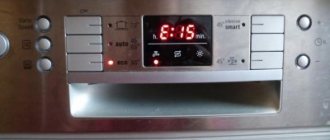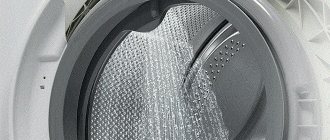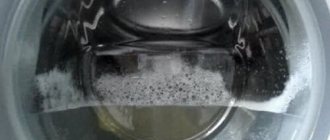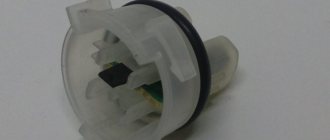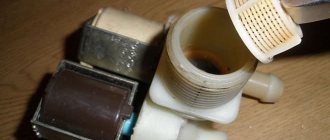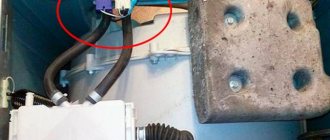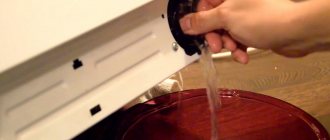Beko dishwasher error codes
How to stop the program and unlock the door
| Fault codes | What does it mean | Reasons for appearance | DIY repair |
| 0000 | No water intake. | 1. There is no water in the water supply, or the pressure is too low. |
2. The inlet valve shuts off the supply.
3. The PMM inlet hose is clogged or damaged.
2. Open the inlet tap to full capacity.
3. Inspect the inlet hose. It must not be bent or damaged.
1. The heating element has burned out or its contacts have been damaged.
1. Conduct diagnostics of the heater and its wiring. Use a multimeter to ring the contacts of the heating element. If damaged, replace the part.
1. The thermostat contacts burned out during a short circuit.
1. Inspect and replace the heater with a serviceable part.
1. Incorrect operation of the thermistor, which sends incorrect signals to the control module.
1. Check the thermistor and replace it.
2. The pump is blocked by a foreign object.
1. Check and clear the drain filter, pump, and drain hose from blockages.
2. Wearing gloves, you need to inspect the pump impeller, which could be blocked by glass fragments.
2. The wiring of the pressure switch is broken.
3. Fill valve does not work.
2. Check the contacts of the pressure switch.
3. Diagnose the valve problem. Install a new part.
What to do if the dishwasher is still under warranty
For at least the first year after purchase, do not repair it yourself - by doing so, you will deprive yourself of warranty benefits. The warranty period and conditions must be clarified when purchasing household appliances.
If you use detergents that are not intended for dishwashers to wash dishes, warranty repairs may be denied.
During this period, you can work to remove blockages in the dishwasher filters. In addition, it is allowed to clean the holes in the sprinkler rocker arms from dirt and food debris if the PMM begins to wash dishes poorly.
Do not forget that many defects in work occur due to non-compliance with operating rules. The machine may not work only because there is no water in the water supply or someone has closed the inlet ball valve.
Modern authorized service centers have all the necessary tools and spare parts for warranty repairs
Therefore, you need to periodically check: the presence of electricity in the sockets, the water pressure in the water supply and the absence of blockages in the sewer. If you connect the dishwasher to the communications yourself, make sure you did everything correctly. An error may result in the PMM refusing to wash dishes.
Do not take warranty equipment for repair yourself; the store should arrange delivery
Remember: you do not need to take the PMM yourself for repairs to a service center under warranty. This must be done by the store that sold you this equipment, because it weighs more than 5 kg. It is quite possible that technicians will volunteer to repair the device at home.
"Weak points" of famous brands
Every technology has its weaknesses, no matter how advanced the company and its products are.
Electrolux
- problems with water supply and drainage;
- heating systems;
- electronics;
- impellers;
- leaks.
Hotpoint-Ariston
- "Aquastop" system;
- heating elements;
- pressure switch;
- valves
Bosch
- "Aquastop" system;
- Launchpad problems;
- clogged filters;
- circulation pump;
- hatch lock.
Recommendations and lifehacks
- Clean dishes from food residues before loading them into the PMM.
- Load the upper basket with small, not heavily soiled dishes.
- Load the lower basket with the dirtiest dishes.
- Start unloading dishes after drying from the bottom section.
- Do not overload the PMM.
- Carry out preventive cleaning of parts regularly - at least once every 3 months.
- Use professional dish degreasing products.
- Do not overuse short wash cycles.
What causes most breakdowns?
Unfortunately, in many cases dishwasher malfunctions are caused by users. Owners who do not carefully read the operating instructions create problems for themselves.
The most common causes of their occurrence are:
You need to connect the dishwasher with skill or entrust this work to professionals
If the connection to communications is incorrect, the PMM may not work. One example of installation errors is exceeding the maximum length of hoses connected to the water supply and sewerage systems. As a result, the drain pump (hereinafter also referred to as the pump) may not have enough power to pump liquid into the sewer, and water from the water supply will not flow into the tank in sufficient volume.
By placing dishes with a large amount of dried dirt into the appliance, you risk clogging the dishwasher filter.
Before washing in a PMM, the surface of the dishes must be cleaned of dried and burnt pieces of food - this is one of the important rules of operation. Otherwise, even soaking and prolonged intensive washing will not help to wash kitchen utensils well. In addition, the machine may stop working if the filters, clogged with dirt, stop passing liquid through them. Therefore, clean the filter from grease and dirt after each operating cycle and at least once a week.
If you use household chemicals that are not intended for dishwashers, this may result in poor dishwashing or damage to the unit.
The use of cheap and low-quality preparations leads to poor quality of washing and rinsing. For example, stains with a whitish tint remain on the surface. Sometimes this can cause high levels of foaming and liquid leakage into the pan, causing the dishwasher to stop working and an error code to appear on the control panel.
Abundant foam in the chamber makes it difficult to wash the utensils
In addition to the above reasons, there are also those that arise due to the fault of utility services. Eg:
If there is a large amount of salt impurities in the water, regenerative salt cannot soften the liquid to the required level. This situation leads to the appearance of lime deposits in the PMM parts and on the walls of the working chamber. The scale that forms on the surface of the flow-through electric heater (hereinafter also referred to as the heating element) does not allow it to heat the water to the required level. Limescale deposits clog the holes in the sprinkler arms, causing the cleaning quality to drop sharply.
This amount of scale is unacceptable for a dishwasher - it urgently needs to be washed with a special cleaning agent
Powerful voltage surges in the electrical network (sometimes up to 380 volts) are fraught with fatal consequences for household appliances. The control units of dishwashers suffer the most from such processes. In most cases, experienced technicians will check and replace the burnt part. But it also happens that you have to change the entire module.
Control triac in the control unit, burnt out due to surge voltage
The last cause of damage to PMM is wear of parts or defects that arise during their production. Over time, this leads to breakdown of the household appliance.
Readers can learn how a dishwasher works and what breaks in it from the following video:
Preventing the problem from recurring
To do this, follow these simple rules:
- monitor the hoses, do not allow kinks or pinching;
- monitor the filter - carry out preventive cleaning once a month;
- if voltage surges are observed, install a stabilizer;
- if there is a frequent drop in pressure in the pipeline, install a hydraulic station;
- use only special dishwashing detergents;
- if the water is hard, carry out preventive cleaning once a month to remove scale, or constantly use anti-salt products;
- treat the door with care, closing it carefully, preventing foreign objects from entering.
Find out everything you need to know about dishwasher water in this section.
Causes of malfunctions and step-by-step instructions for eliminating them
The main reasons why the dishwasher does not fill with water:
In the dishwasher, the program sets a certain time for the water to fill. On average 10-15 minutes. If within a specified period of time the level sensor does not inform the control unit that the required amount of water has been collected, the machine stops executing the program. Having established the reason for the lack of water supply, measures should be taken to eliminate them.
The door is broken
The dishwasher does not fill with water and is humming - this indicates a breakdown associated with the water supply path:
The dishwasher does not fill with water and there are no extraneous sounds - an electronic failure. "Silence" reports problems with:
List of provoking factors depending on the dishwasher model
All dishwashers work on the same principle. But everyone has different spare parts, different software, different “weak” points:
Indesit - the most common problem with water intake is related to the filling system; it needs to be cleaned more often.- For Zanussi, the weak point is the filling valve.
- Beko's water level sensor falls off more often than other models. This leads to water overflow or no water at all.
- In the second generation of dishwashers from the Bosch model range, the lack of water supply is due to an electronic control failure. The machines are very sensitive to low water pressure.
- The third generation of the Bosch model range has increased sensitivity to excess pressure. With it, the “electronic sensor” does not have time to “track” the filling of water and stops the program.
Typical malfunctions of Beko washing machines
By entrusting the inspection of your car to an experienced technician, you can rest assured that he will quickly and professionally find what the problem is. But due to the high prices for services, many home craftsmen are trying to save money and repair the Beko washing machine themselves.
Almost any SMA model can be repaired at home: ELB 57001 M, RKB 58801 MA, LNU 68801, etc.
This approach is quite justified - often repairs are exorbitantly expensive, and sometimes the price is such that you can buy a new machine. At the same time, even the most “killed” car can last for several more years after repair.
Don't want to throw away your Veko machine and buy a new one? Try to figure out the problem yourself and fix everything yourself.
The design of the Beko washing machine also determines the nature of its breakdowns. Let's look at typical malfunctions of washing machines of this brand:
Important! There may be other signs of failure. We looked at the most common ones among Beko SM users in Russia.
Preventive measures
To ensure that your Beko washing machine breaks down as little as possible, it requires regular preventive maintenance.
- On average, once every 6 months, and then depending on how often the washing machine is used, you need to clean the drain filter from accumulated dirt, and also wash the mesh at the inlet.
- The washing machine must be connected to the network through a voltage stabilizer. It is able to save electronics from unexpected voltage drops.
- A cleaning filter must be installed at the entrance to the washing machine. This will reduce scale deposits and extend the life of the heating element.
- Electronics are one of the weakest points of Beko and other brands of machines, so it is better to install the equipment in a dry room to avoid corrosion and liquid getting on the system board.
Beko dishwasher error codes.
| Error code | Cause of occurrence | How to fix |
| 0000 | No water supply | 1.Check if the tap is open. 2. It is necessary to check the water pressure in the water supply. 3.Clean the filter mesh in the inlet hose and inlet valve. 4.The inlet hose may be bent, inspect. |
| 000 | No heating. General heating error | 1. Check the heating element (operating resistance is approximately 30 Ohms). 2.Check the thermostat. |
| H1 | Temperature sensor faulty | Measure the resistance of the sensor (working sensor 4.7 kOhm). |
| H2 | Malfunction of heating element (heating element) | 1.Measure the resistance of the heater (operating resistance is approximately 30 Ohms). 2.Check the control board. |
| H3 | Heating is always on | 1.Look at the temperature sensor. 2.Look at the control board. |
| H4 | Filling valve triac is faulty | 1. Check the triac on the board. 2.Replace the board. |
| H5 | No drain | 1.Clean the drain pump filter. 2.Check the drain hose for permeability. 3. Check at what level the drain hose is fixed (must be at least 60 cm from the floor). 4.Check the drain pump. |
| H6 | Circulation pump malfunction | 1.Check the circulation pump. 2.Look at the control triac on the board. 3.Replace the board. |
| H7 | Pressostat (water level sensor) error | 1.The car door is not closed tightly, close it. 2.Check the water tap. 3.Check the wiring between the water level sensor and the board. 4.Replace the pressure switch. 5.Check the power supply to the fill valve, replace the valve. 6.Replace the control module. |
When carrying out repairs yourself, remember to be safe. Be sure to turn off the power to the machine before starting repairs.
The housing is leaking
The presence of a leak, in most cases, indicates wear of the drain pump gaskets. In this case, the dishwasher must be turned upside down and replaced. If a leak is detected from the door, you should press it harder and check the condition of the seal.
Important! Mechanical damage, wear of the sealing element are reasons for urgent replacement of the part; this is quite simple to do: you need to carefully remove the old rubber band and insert a new one into the grooves.
When loading dishes into the dishwasher, you need to make sure that large items do not prevent the door from closing. It is also important not to exceed the maximum number of items allowed. Otherwise, the quality of washing will be unsatisfactory.
If the door does not close and starting fails, the problem may be more serious. It is worth inspecting the locking device, since the reason for the inoperability of the equipment may be its malfunction. If there are any breakdowns, the part will have to be replaced; it cannot be repaired.
It is also important to check the hose connections. You need to tighten them well if they are loose. If necessary, worn clamps are dismantled and new ones are installed in their place.
Beko dishwasher repair
Beko dishwasher repair
Beko dishwashers are manufactured by the Turkish corporation Koç Holding founded in 1926. The first dishwasher was released in 1996.
Quick online diagnostics of dishwasher faults (Simply select a problem from the list and find out the approximate breakdown)
When carrying out repairs yourself, remember your safety!
Disassemble without disconnecting the equipment from the mains!
It is best to use the services of an experienced technician who is familiar with any problems and can fix the problem. If your dishwasher breaks down, entrust the repair to a professional: he will be able to perform all the steps quickly, efficiently and safely.
Decoding error codes for Beko dishwashers
1. The temperature sensor (thermistor) is faulty. 2. Too much water has been added to the tank (for example, due to incorrect data from the water level sensor). 3. Open circuit in the heating element circuit. 4. Heater (heating element) burned out 5. Control controller failure.
1. Broken wire or loose contact in the temperature sensor circuit. 2. Short circuit in the sensor circuit. 3. Incorrect connection of contacts from the sensor on the control controller.
1. Broken wire or loose contact in the heating element circuit. 2. The heating element has burned out. 3. The relay on the electronic board that controls the operation of the heating element has failed.
1. The temperature sensor or water level sensor is faulty. 2. Open circuit in the heating element control circuit. 3. Management controller failure.
1. The drain hose is defective or clogged; air bubbles have accumulated in the hose. 2. Blockage in the pan. 3. The drain filter is clogged. 4. Incorrect drain connection. 5. Problems with the drain pump. 6. Open circuit in the power supply circuit of the pump or pressure switch. 7. The pressure switch is broken.
1. Open circuit in the pump motor circuit. 2. Foreign objects have gotten into the pump blades and are blocking them. 3. The pump is faulty. 4. The triac has failed. 5. Control board failure.
How to call a specialist?
Requests for repairs are accepted daily, from 8 am to 10 pm by phone or using an online application.
8 (985) 181 – 02 – 88 (Viber, WhatsApp)
Leave a request for repairs
Important! When contacting, please provide the following information: Your contact information: name, phone number and address, make of the machine, if possible, send a tag with the serial number and product code of the machine and the day and time of arrival of the technician that suits you.
The exact model of the machine is indicated on the tag on the dishwasher body or stickers, as well as in the operating instructions. If you have already purchased replacement parts yourself, please indicate only the make of the machine. For example, BEKO DFN 6838R.
places where dishwashers may contain a sticker with all the necessary service information.
2. On the back wall. The back wall of the dishwasher is a traditional place for all kinds of service information. If you couldn’t find a sticker with a number on the front, then it was probably preserved on the back wall.
3. In the passport or instruction manual. Finally, the serial number can sometimes be found on the documents that come with the purchase of the dishwasher. As a rule, the number is located in the passport or warranty card.
The arrows show the location of the tags
Dishwasher manufacturers encode on the tag (sticker) what they produced, when, where and from what parts. This information is encoded in two sequences of numbers (letters) product and serial numbers. Their combination is unique and applies only to one specific dishwasher.
Please take a photo of these tags
To maximize the life of your dishwasher, you need to carefully read the operating instructions. If you have lost it, here you can select your model and download it in pdf format.
Problems with Beko air conditioners
Let's look at what malfunctions of the Beko air conditioner owners most often encounter, and carefully consider how to fix it.
If the air conditioner does not cool
There are several reasons why an air conditioner stops cooling. Our list ranks them from most likely to least likely.
To identify the cause of a breakdown, you need to test each cause, starting with the first:
- If the air filter is clogged, air will not be able to circulate through the air conditioner. This reduces its cooling capacity. A dirty filter can cause the evaporator coils to freeze. In this situation, the filter needs to be washed or replaced with a new one.
- If the condenser coils become dirty, they will not be able to dissipate heat as refrigerant flows through them. As debris accumulates on the coils, the air conditioner begins to work longer and harder to produce cold. Eventually it will run continuously. The air conditioner coils can be cleaned.
- Rarely, the cause of this situation is a compressor malfunction. First you need to check the compressor capacitor and overload fuse. If a fault is found in the compressor, you will have to call a technician.
- The cause of the problem may lie in the thermostat. The thermostat controls the temperature, when the air temperature increases, the thermostat turns on the fan and compressor. If it is faulty, it will not be able to cool. To test the thermostat, turn on the cool mode and use a multimeter to check for continuity. If it is broken when the air conditioner is operating for cooling, you will have to change the thermostat.
- All systems may work normally, but the cause of the problem may lie in the thermistor - a temperature sensor on the control board. If the air temperature rises, the resistance value on the thermistor decreases. The serviceability of the sensor is checked with a multimeter. If its resistance does not change with temperature changes, the thermistor will have to be replaced.
- The cause of the error code can always be a breakdown of the control board.
Some parts can be repaired. In case of some breakdowns, units and components that cause the split system to cool poorly cannot be restored and will have to be replaced.
How to set up climate control equipment for cooling is described in detail in our recommended article.
Fan doesn't work
If the fan stops working, check it for the following faults, starting with the most common:
- The fan motor has a 2-shaft design. Such an electric motor has bearings that wear out first. To determine if this is the case, rotate the shaft. This is the most expensive failure because if the shaft does not rotate, the fan motor will have to be replaced.
- If you turn the blades by hand and they do not rotate freely, this also means that the motor bearings are worn out. If the blades are spinning, check the power input. If there is power, but the motor still does not work, you will have to change it.
- If the defect occurs in the relay board, it means that voltage will not be supplied to the motor. The relay board can be replaced and is inexpensive.
- The temperature control thermostat may burn out contacts. To check, you need to use a multimeter to check its continuity.
- A malfunctioning thermostat may prevent the fan from operating. To check, you need to set the air conditioner to cooling mode and check the thermostat for continuity of wiring with a multimeter. If damage to the wire is detected, it must be replaced and loose contacts restored. If this is not the case, you will have to change the thermostat.
All errors can be generated by a damaged control board. Naturally, in this case there must be a replacement.
Also, the reason the fan stops may lie in a malfunction of the thermistor, capacitor, or rotary switch. If the cause of the failure is the fan motor, it will have to be replaced. Worn out or burnt out fan motors cannot be repaired.
Compressor does not work
If the compressor stops working, you should check:
- Temperature control thermostat electrical contacts that may burn out. In this case, the thermostat will turn on the fan motor, but not the compressor.
- The temperature control board may stop supplying current to the compressor. The board can only be replaced.
- The thermostat controls the temperature and when it rises above normal, the thermostat activates a switch to send current to the compressor and fan.
- The fuse may blow over time. You can check if this is the reason using a multimeter.
- Very rarely, the compressor itself also fails. First you need to carefully check the serviceability of the fuse and capacitor. The compressor can only be replaced in a workshop.
Even more rare causes of compressor inoperability are problems with the thermistor, breakdown of the relay board, or a defect in the main control board. The capacitor may burn out.
Correct installation of climate control equipment is very important to prevent breakdowns. You must not violate the manufacturer’s recommendations set out in the instructions for the device. Be sure to observe the height and distance between blocks specified in the technical documents
If the equipment was installed unevenly, the drains will become clogged first, and then the engine and radiator will break.
Why is the air conditioner so noisy?
The split system can operate noisily, and no error will be displayed on the display. In this situation, it is important to react in time and find the causes of the noise. Otherwise, the breakdown may worsen and lead to failure of the climate control equipment.
What could be the reasons for noisy operation:
- Compressor wear. It should be noted that even a noisy compressor can still continue to work for years.
- Over several years of operation, the bearings of the fan motor may become caked with grease.
- During prolonged use, the fan blade may become damaged or deformed and begin to touch the fan housing. It will have to be replaced.
- The fan wheel must be stable. If it is loose, it will have to be replaced.
A noisy air conditioner, of course, creates certain inconveniences during operation, but this does not mean that you need to immediately change spare parts. First you need to find out the cause of the noise; perhaps it is not so serious.
Water is leaking from the indoor unit or floor unit
If a puddle collects under the indoor module, there may be several reasons:
- If water flows out of a monoblock unit onto the floor, it means that it is not level during installation and falls forward. The floor-standing unit should be positioned so that it has a slight slope of 1-2 degrees.
- The drainage is clogged: you need to clear or blow out the clog.
- The drainage pipeline was installed incorrectly. Everything needs to be fixed.
- Pump failure.
Regular cleaning of the drainage pipeline is specified in the instructions for use.
The air conditioner drain pipe should be cleaned a couple of times a year during heavy use.
After the split system is installed correctly, nothing should drip from anywhere, unless this is a feature of the drainage system.
Fighting heat exchanger freezing
A freezing heat exchanger is a fairly common problem, which most often occurs due to lack of regular cleaning or replacement of the air filter. If it is clogged, the air flow through the evaporator coils is reduced.
The evaporator coils cool and moisture condenses on the coils, gradually freezing. This causes the evaporator coil assembly to freeze. Solving the problem - replacing the air filter
Maintenance of the air conditioner must be carried out regularly in accordance with the requirements of the accompanying instructions.
Dishwasher error codes
Modern Bosch dishwasher modules are equipped with an intelligent self-diagnosis system, thanks to which, in the event of the slightest malfunction, an alert occurs through codes that appear on the device display. The error code is a combination of letters and numbers. In order for the user of the dishwasher to clearly understand the problem of failure or breakdown, it is enough to navigate the meanings of error combinations.
Bosch dishwasher errors
There can be many errors signaling unit malfunctions, since a dishwasher is a household appliance of complex design with a large number of systems, technologies and sensors.
Let's describe the most common codes.
Along with standard error codes, there are combinations consisting of several letters and 2-3 numbers, for example: 2H, h, A5, S3, 4, 8, 16, which a special diagnostic test will help determine.
This error coding system is only suitable for dishwasher modules equipped with an LED display.
Problems with Electrolux models
If the error code appears on the display for the first time, you can simply try to reboot the unit: unplug it and wait 20–30 minutes, and then start it up. If, when you turn it on again, the error code appears again, you need to decipher it to understand the essence of the problem. Most often, users encounter the following code combinations.
In addition, a little less often, users may encounter codes on the display such as ib0 with 11 blinks - the water turbidity sensor is broken, iC0 (12) - the electronic board needs to be replaced, id0 (13) - the tachometer has failed and iF0 (14) - Exceeding the water collection time.
Preventive measures
To ensure that your Beko washing machine breaks down as little as possible, it requires regular preventive maintenance.
- On average, once every 6 months, and then depending on how often the washing machine is used, you need to clean the drain filter from accumulated dirt, and also wash the mesh at the inlet.
- The washing machine must be connected to the network through a voltage stabilizer. It is able to save electronics from unexpected voltage drops.
- A cleaning filter must be installed at the entrance to the washing machine. This will reduce scale deposits and extend the life of the heating element.
- Electronics are one of the weakest points of Beko and other brands of machines, so it is better to install the equipment in a dry room to avoid corrosion and liquid getting on the system board.
